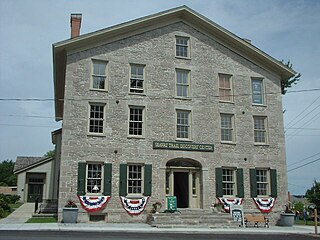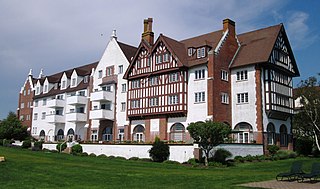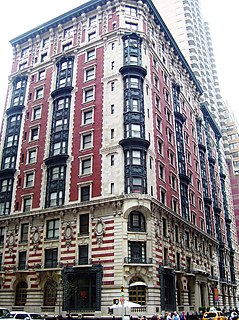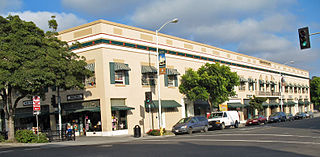
Mount Adams is a mountain located in Essex County of New York. Atop the mountain is the Mount Adams Fire Observation Station, added to the National Register of Historic Places in 2006.

Maple Springs is a hamlet located within the Town of Ellery in Chautauqua County, New York, in the United States at an elevation of 1,312 feet (400 m) above sea level. It is situated along the east shore of Chautauqua Lake, between the villages of Mayville and Bemus Point. New York State Route 430 runs through the hamlet. The postal code is 14756, and its permanent population as of the 2010 United States Census was 110 with an average age of 49.3 years of age living in 136 housing units.

This list is intended to be a complete compilation of properties and districts listed on the National Register of Historic Places in Rensselaer County, New York, United States. Seven of the properties are further designated National Historic Landmarks.

The Park Shelton is a historic condominium building located at 15 East Kirby Street in Midtown Detroit, Michigan. Built in 1926 as The Wardell hotel, the building was therefore listed under this name in the National Register of Historic Places in 2007.

The Hotel Lucia, formerly the Imperial Hotel, is a historic hotel building in downtown Portland, Oregon, United States. It was built in 1909 as an extension of the adjacent, original Imperial Hotel. The original Imperial building was made into a separate hotel in 1949, renamed the Plaza Hotel, and after a period of non-hotel use in the 1980s it today operates as the Kimpton Hotel Vintage Portland.

Belmont Hotel is a historic hotel building located at Belmont in Allegany County, New York. The three story brick building was constructed in 1890. The first floor features cast iron storefronts and arcaded loggia. Located adjacent to the Allegany County Courthouse, the hotel played an important role in the county's social, business, and political affairs.

Andrew Jackson Warner, also known as A. J. Warner, was a prominent architect in Rochester, New York.

The Pierce Pennant Motor Hotel, also known as the Candle Light Lodge, is a historic hotel complex that is located on what once was U.S. Route 40, which is now known as Business Loop 70 West in Columbia, Missouri. The hotel complex was constructed in 1929 and is in the Colonial Revival style. The hotel was also a gas station and garage, and was owned by Pierce Petroleum Company, a subsidiary of Standard Oil. Initially the hotel and garage complex was to be one of several along U.S. Hwy 40, each to be spaced about 150 miles apart from New York to San Francisco.

Union Hotel, also known as Barrow's Hotel, is a historic hotel located at Sackets Harbor in Jefferson County, New York. It is a 3 1⁄2-story stone building, 51 feet by 69 feet, over a full basement. The original structure was built in 1817–1818. The interior features distinctive Federal woodwork. It functioned as a hotel into the 1860s, then was used as a Masonic Lodge. In 1972 New York State acquired the building and rehabilitated it for use as the Visitor Center for the Sackets Harbor Battlefield State Historic Site. In July 2000, an addition was built and it was converted to serve as the Seaway Trail Discovery Center.

Hotel Delaware is a historic hotel building located at East Branch in Delaware County, New York, United States. It was built in 1891 and enlarged after a fire in 1908. It is a large three story wood framed building, 40 feet wide and 70 feet deep. It features a two-story verandah on the front facade supported by Doric order columns on the first story.

Montauk Manor is a historic resort hotel located in the hamlet of Montauk in Suffolk County, New York, on Long Island. It was built in 1926 by Carl G. Fisher and is a three-story, 140 decorated condominium apartments in the Tudor Revival style. It was designed by Schultze and Weaver, the firm responsible for several Miami Beach-area hotels, The Breakers in Palm Beach, The Biltmore in Los Angeles, and The Pierre, The Sherry-Netherland and the former Waldorf-Astoria in Manhattan, New York City.

Shelburne Playhouse is a historic theatre located at Ferndale in Sullivan County, New York. It was built in 1922 as part of a small resort known as the Shelburne Hotel and used as the hotel social hall. It is a long, rectangular wood-frame building, 95 feet long and 35 feet wide. It consists of two components: a large five-by-four-bay structure that houses the main seating area / dance hall and a slightly lower three-by-one-bay entrance pavilion. The building is coated in stucco with applied wooden battens and a surmounted by a gable roof in the Tudor Revival style.

The Grand Hotel is located at 1232–1238 Broadway at the corner of West 31st Street in the NoMad neighbourhood of Manhattan, New York City. It was built in 1868 and was designed by Henry Engelbert in the Second Empire style. Englebert designed the hotel for Elias S. Higgins, a prosperous carpet manufacturer and merchant, who had also utilized Engelbert's services to put up a marble-fronted warehouse on White Street near Broadway, and would go on to employ him to design the Grand Central Hotel as well.

For the hotel in Harrison, Arkansas see Hotel Seville

The Green Shutter Hotel is a historic hotel building located in downtown Hayward in Alameda County, California, United States. The building was listed on the National Register of Historic Places in 2004, and is on the California Register of Historical Resources.

The Hotel deLuxe is a hotel located in southwest Portland, Oregon, in the Goose Hollow neighborhood. Built in 1912 as the Mallory Hotel, the hotel was commissioned by Rufus Mallory, a Portland lawyer and politician, and is listed on the National Register of Historic Places under its original name. It was sold in 2004, renovated, and reopened as the Hotel deLuxe in 2006.

The Decker House Hotel is a historic building located in Maquoketa, Iowa, United States. James Decker, an entrepreneur from Watertown, New York held numerous real estate holdings in and around Maquoketa. He built the first Decker House, a frame structure, in 1856. After Maquoketa was named the county seat in 1873, Decker decided to replace it. The three-story, brick, Italianate building was designed by Watertown architect W.W. Tucker. Its decoration is limited to the north and east elevations. Noteworthy, is its metal cornice and window hoods. It opened in May 1878, and it had two other competitors in town at that time. Following his death in 1881, James Decker's son Leonard took over his holdings in New York and Iowa. He moved into the Decker House in 1885 and died there in 1900. The building has subsequently lost its entrance porch, original front doors and the pediment over the cornice. It was listed on the National Register of Historic Places in 1978.























